| Виртуальный Владимир » Город Владимир » Old Russian Towns » Vladimir » Historic buildings » Cathedral of the Assumption » frescoes |
 ...
... frescoes
frescoes exterior
exterior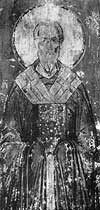 Nothing remains of the original paintings of 1161 apart from the fragment which we have already noted in the band of blind arcading on the north wall. When the new walls were added in 1189 the interior of the original building was entirely restored. The floors were decorated with a rich mosaic of majolica tiles and plates of copper like burnished gold, and the frescoes were renewed with new ones being added. A few fragments have survived, although some of them are obscured by the new iconostasis. The visitor is able to examine the two figures of Artemius and Abraham on the inside walls of the aperture leading into the southwest corner of the old cathedral. The figures are extremely well framed under arches decorated with stylised acanthus leaves and resting on slender columns. This means that they blend in well with the building as a whole and with the band of blind arcading on the outside in particular. If the figures of saints in other parts of the cathedral, particularly on the columns, were also surrounded by arched frames they would have emphasised the lightness of the supports rising up like a series of slender arches resting one on top of the other. These frescoes were the work of Russian painters who adhered strictly to the artistic canons of their time. The highly stylised frontal figures of the saints are void of any suggestion of movement or life. On the wall of the south gallery there is a fragment of a painting commissioned by Bishop Mitro-phanes on the eve of the Mongol invasion in 1237. It is part of the figure of a warrior. It is possible that all the painting in the princes' burial vault depicted subjects connected with war.
Nothing remains of the original paintings of 1161 apart from the fragment which we have already noted in the band of blind arcading on the north wall. When the new walls were added in 1189 the interior of the original building was entirely restored. The floors were decorated with a rich mosaic of majolica tiles and plates of copper like burnished gold, and the frescoes were renewed with new ones being added. A few fragments have survived, although some of them are obscured by the new iconostasis. The visitor is able to examine the two figures of Artemius and Abraham on the inside walls of the aperture leading into the southwest corner of the old cathedral. The figures are extremely well framed under arches decorated with stylised acanthus leaves and resting on slender columns. This means that they blend in well with the building as a whole and with the band of blind arcading on the outside in particular. If the figures of saints in other parts of the cathedral, particularly on the columns, were also surrounded by arched frames they would have emphasised the lightness of the supports rising up like a series of slender arches resting one on top of the other. These frescoes were the work of Russian painters who adhered strictly to the artistic canons of their time. The highly stylised frontal figures of the saints are void of any suggestion of movement or life. On the wall of the south gallery there is a fragment of a painting commissioned by Bishop Mitro-phanes on the eve of the Mongol invasion in 1237. It is part of the figure of a warrior. It is possible that all the painting in the princes' burial vault depicted subjects connected with war.
In 1408 the great painter Andrei Rublev was sent from Moscow to restore the cathedral frescoes which had been damaged by fire, together with his friend Daniil Chorny and some apprentices. The damage was so considerable that they had to produce a completely new set of paintings, although they kept for the most part to the original positioning of the various scenes. The visitor should bear in mind that the fragments of these frescoes which have survived retain only a fraction of their original beauty. They have suffered all sorts of damage, including inept attempts at restoration, and in some places the paint has been removed entirely.
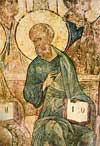
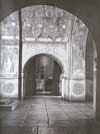 Most of the surviving frescoes are to be found under the choir gallery and form part of the Last Judgment. On the arch there are the figures of angels blowing their trumpets to summon the dead to judgment. On the keystone is a huge hand holding a number of tiny human figures - a literal, naive illustration of the biblical words "the souls of the righteous are in God's hand". The figure of Christ sitting in judgment with a halo of many-winged seraph is on the vault. Above his head angels are rolling up the scroll of the heavens. Here too in a medallion are the four beasts symbolising the four kingdoms. On the wall beneath the vault stands the judgment seat with the kneeling figures of Adam and Eve, the Virgin Mary and John the Baptist interceding on man's behalf. Here too we see the apostles Peter and Paul on the sides of the vault with the elders of the apostolic tribunal and the angelic host. On the flat surface of the north pillar under the choir-gallery is the angel appearing to the prophet Daniel. The most interesting section of the composition, although it has almost disappeared, is to be found on the opposite, south side above the arch. This shows the earth and sea represented by female figures, with a ship symbolising the sea, yielding up their dead. Further on, starting with the flat surface of the south pillar under the choir-gallery, is the final scene of the Last Judgment -the righteous entering paradise. This is continued on the small south arch and the side of the southwest vault over the gallery, where we see the head of the procession led by the apostle Paul. On the wall of the south arch stand the wooden gates of paradise guarded by an angel with a fiery sword, and the figure of the Penitent Robber who is the first to enter. Further along, on the curve of the arch is paradise itself with the three forefathers, and the small figures of the righteous resting in Abraham's bosom, while other righteous souls stand and wait their turn. Finally, on the north face of the arch we see the Queen of Heaven surrounded by angels.
Most of the surviving frescoes are to be found under the choir gallery and form part of the Last Judgment. On the arch there are the figures of angels blowing their trumpets to summon the dead to judgment. On the keystone is a huge hand holding a number of tiny human figures - a literal, naive illustration of the biblical words "the souls of the righteous are in God's hand". The figure of Christ sitting in judgment with a halo of many-winged seraph is on the vault. Above his head angels are rolling up the scroll of the heavens. Here too in a medallion are the four beasts symbolising the four kingdoms. On the wall beneath the vault stands the judgment seat with the kneeling figures of Adam and Eve, the Virgin Mary and John the Baptist interceding on man's behalf. Here too we see the apostles Peter and Paul on the sides of the vault with the elders of the apostolic tribunal and the angelic host. On the flat surface of the north pillar under the choir-gallery is the angel appearing to the prophet Daniel. The most interesting section of the composition, although it has almost disappeared, is to be found on the opposite, south side above the arch. This shows the earth and sea represented by female figures, with a ship symbolising the sea, yielding up their dead. Further on, starting with the flat surface of the south pillar under the choir-gallery, is the final scene of the Last Judgment -the righteous entering paradise. This is continued on the small south arch and the side of the southwest vault over the gallery, where we see the head of the procession led by the apostle Paul. On the wall of the south arch stand the wooden gates of paradise guarded by an angel with a fiery sword, and the figure of the Penitent Robber who is the first to enter. Further along, on the curve of the arch is paradise itself with the three forefathers, and the small figures of the righteous resting in Abraham's bosom, while other righteous souls stand and wait their turn. Finally, on the north face of the arch we see the Queen of Heaven surrounded by angels.
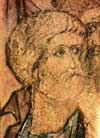 In the northern section under the gallery there must have been scenes of punishment and infernal torment, but these have not survived. There is nothing to indicate how this picture of divine retribution was depicted. However, the sections of the composition that have survived show that the popular conception of the Last Judgment and the way it was depicted by artists had changed radically by the time of the Russian Renaissance. The tremendous hardships which the country endured under Mongol rule had by then receded into the past. The defeat of the Golden Horde led by Mamai at the Battle of Kulikovo in 1380 heralded the end of Mongol supremacy and the country entered a period of national awakening in which despondency was replaced by hope. This explains the spirit of peace and joy which radiates from Rublev's paintings. The figures of Christ sitting in judgment, the apostles, and the angels have nothing grim or frightening about them. On the contrary, they are slender and youthful with their graceful small heads and sloping shoulders. In their representation of the saints and the righteous, which closely resemble the faces of ordinary Russian people, Andrei Rublev and Daniil Chorny were striving to give artistic expression to the ethical ideas of their heroic age by making their figures radiate spiritual strength and moral purity.
In the northern section under the gallery there must have been scenes of punishment and infernal torment, but these have not survived. There is nothing to indicate how this picture of divine retribution was depicted. However, the sections of the composition that have survived show that the popular conception of the Last Judgment and the way it was depicted by artists had changed radically by the time of the Russian Renaissance. The tremendous hardships which the country endured under Mongol rule had by then receded into the past. The defeat of the Golden Horde led by Mamai at the Battle of Kulikovo in 1380 heralded the end of Mongol supremacy and the country entered a period of national awakening in which despondency was replaced by hope. This explains the spirit of peace and joy which radiates from Rublev's paintings. The figures of Christ sitting in judgment, the apostles, and the angels have nothing grim or frightening about them. On the contrary, they are slender and youthful with their graceful small heads and sloping shoulders. In their representation of the saints and the righteous, which closely resemble the faces of ordinary Russian people, Andrei Rublev and Daniil Chorny were striving to give artistic expression to the ethical ideas of their heroic age by making their figures radiate spiritual strength and moral purity.
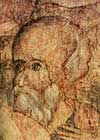 The angels with trumpets on the entrance arch are infused with a remarkable spirituality and beauty. They have nothing in common with the terrible heralds of the Last Judgment calling the dead souls to judgment. Their bodies have a supple, feminine grace and seem to be almost weightless. Their beautiful heads rest gracefully on slender necks, and their figures seem to vibrate as if the artist were striving to capture that elusive moment when their feet have barely touched the ground and their wings are still spread in flight. The slender trumpets in the hands of these heralds of judgment are like shepherds' horns incapable of emitting terrifying sounds. The powerful, naked figures of bearded hermits in the arch of the south wall have much in common with the angels. Their bodies have the same feminine, rounded, flowing lines. A comparison of these figures with the stiff, severe ones of Artemius and Abraham next to them painted in 1189, gives a clear illustration of the different outlooks on life prevalent in the two periods, as expressed in their art.
The angels with trumpets on the entrance arch are infused with a remarkable spirituality and beauty. They have nothing in common with the terrible heralds of the Last Judgment calling the dead souls to judgment. Their bodies have a supple, feminine grace and seem to be almost weightless. Their beautiful heads rest gracefully on slender necks, and their figures seem to vibrate as if the artist were striving to capture that elusive moment when their feet have barely touched the ground and their wings are still spread in flight. The slender trumpets in the hands of these heralds of judgment are like shepherds' horns incapable of emitting terrifying sounds. The powerful, naked figures of bearded hermits in the arch of the south wall have much in common with the angels. Their bodies have the same feminine, rounded, flowing lines. A comparison of these figures with the stiff, severe ones of Artemius and Abraham next to them painted in 1189, gives a clear illustration of the different outlooks on life prevalent in the two periods, as expressed in their art.
 There are four more fragments worthy of mention. On the southwest pillar supporting the central dome there is the magnificent figure of a warrior in golden armour and fragments of a painting of Prince Vladimir. It is possible that after the Battle of Kulikovo subjects connected with war occupied pride of place in painting. On the north arch under the central dome there are parts of a large composition representing the Transfiguration. On the left side of the altar is a particularly interesting fragment showing John the Baptist as a young boy being led into the wilderness by the archangel. The figure of the young boy in a simple, red-patterned shirt, hardly able to keep up with the huge strides of the enormous archangel, whose trailing wing seems to enfold him, is really magnificent.
There are four more fragments worthy of mention. On the southwest pillar supporting the central dome there is the magnificent figure of a warrior in golden armour and fragments of a painting of Prince Vladimir. It is possible that after the Battle of Kulikovo subjects connected with war occupied pride of place in painting. On the north arch under the central dome there are parts of a large composition representing the Transfiguration. On the left side of the altar is a particularly interesting fragment showing John the Baptist as a young boy being led into the wilderness by the archangel. The figure of the young boy in a simple, red-patterned shirt, hardly able to keep up with the huge strides of the enormous archangel, whose trailing wing seems to enfold him, is really magnificent.
In order to build up a complete picture of what the interior of the cathedral looked like after it had been decorated by Andrei Rublev and his fellow-painters we must imagine it with the old iconostasis. The present sumptuous, heavy one with its rich gold carving and elaborate design, made after the cathedral was repaired in 1773-1774, is a typical specimen of eighteenth-century art and clashes violently with the old interior of the cathedral.
The old iconostasis was considerably lower than the present one, but at the beginning of the fifteenth century it was the most impressive of its kind. The icons of the main tier showing the Deesis, i.e., Christ in Majesty, flanked by archangels, apostles and saints, were about ten feet high. These huge figures stood out sharply against the gold background, with their brilliantly simple, rhythmical lines and superb colouring in which dark greens alternated with yellowish-golds and reds, and dark blues with cherry-reds. Andrei Rublev and his fellow painters were past masters at the art of monumental painting. The iconostasis was organically linked with the vast main body of the cathedral and its icons could be clearly seen by a person as soon as he entered the building. The introduction of the iconostasis was an important stage in the development of that complex system of interdependent art and architecture, peculiar to Russian churches, which brought about certain radical changes in the plan of the interior. The tall screen of the iconostasis separated the altar, or sanctuary, from the main body of the church where the congregation stood. The worshippers now saw before them row upon row of icons in strictly prescribed order. Thus the iconostasis gave expression, through a synthesis of painting and architecture, to the mediaeval Russian concept of mutual subordination and unity in both political and ecclesiastical life. It did not so much divide the altar from the congregation, as level and unite all those gathered together for worship.
Оставить комментарий:



 Виртуальный Владимир
Виртуальный Владимир Область
Область Панорамы города
Панорамы города Организации
Организации Улицы и дома
Улицы и дома Добавить организацию
Добавить организацию О городе
О городе










